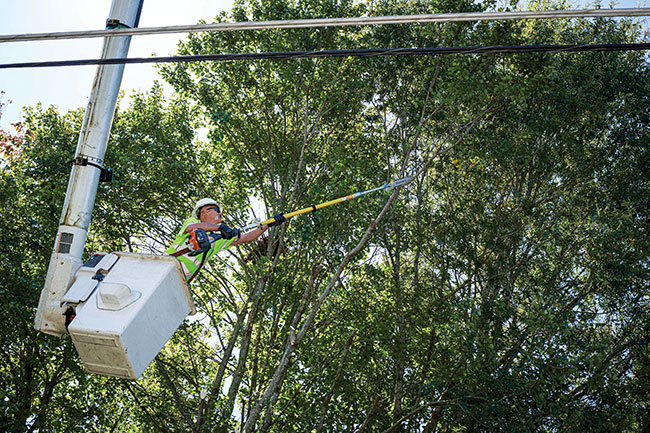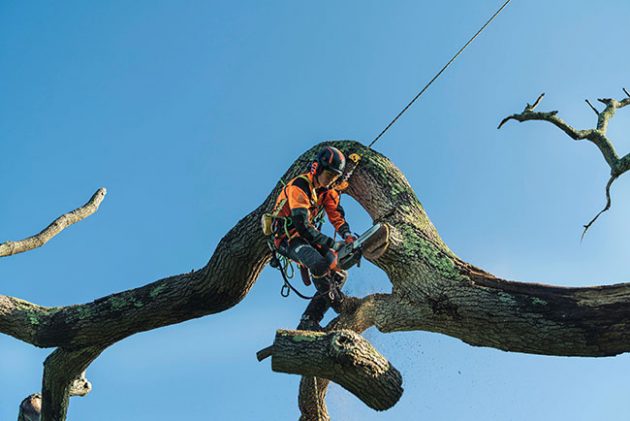
Features
Fall/Winter Preparations
Golf & Landscaping
Municipal
Tree care
5 safety reminders arborists must understand
Arborists must make safety priority No. 1 to prevent serious injuries.
May 5, 2021 By Ben McDermott
 When working high above the ground, use the right tools to ensure you remain safe from fallen branches and overhead wires. Husqvarna photo
When working high above the ground, use the right tools to ensure you remain safe from fallen branches and overhead wires. Husqvarna photo Whether an arborist is working in a bucket, on the ground or in a tree, safety is of utmost importance. Due to the dangerous nature of the job – such as being suspended high above the ground, climbing trees or operating heavy, dangerous equipment – arborists must take the right safety precautions associated with the job to prevent serious injuries.
Globally, commercial arboriculture ranks in the top five most dangerous occupations, according to ArborCanada. Some arborists may tell you that they know at least one other arborist who was either badly injured or lost his life on the job.
No matter how big or small the job, keeping safety top of mind is vital. As a chainsaw and personal protective equipment (PPE) manufacturer working closely with arborists daily, we feel responsible to address the safety needs of arborists, and to help mitigate any risks as much as we possibly can. Throughout our conversations with our arborist network, here are a few of my key learnings when it comes to safety best practices:
Ongoing training is critical to the growth and well-being of the industry
According to the International Society of Arboriculture (ISA), the tree care profession has experienced rapid growth over the past 15 years, and there is a significant amount of knowledge required to perform at the highest level. On top of completing a post-secondary education in the field that includes on-site training or apprenticeship programs, it is recommended that arborists make use of ongoing training throughout their career to gain the proper credentials.
Trade associations like the ISA or even the Tree Care Industry Association (TCIA) offer memberships to those in the tree care industry. Memberships are particularly important; they show that the arborist is willing to stay up to date on the latest techniques and information. If you’re looking to hire an arborist for a job, those with TCIA and ISA memberships are likely to have completed rigorous, on-site training to approach all jobs with safety top of mind. We fully support these associations that shape the tree care professionals today and encourage all arborists to undergo ongoing training for their own safety.
Get familiar with equipment and technique
Investing in the right equipment, and taking the time to learn how to use it correctly, has the potential to prevent serious injuries and even save lives. For tree care professionals just starting their careers, who perhaps have not yet completed on-site training, a good start is getting familiar with things like the ins and outs of a chainsaw, climbing ropes, harnesses and PPE. A quick refresher of the owner’s manual doesn’t hurt.
When it comes to operating a chainsaw, cutting techniques should be considered to ensure safety. This is why ongoing training is so important – arborists must learn, understand and apply the right cutting techniques to each job. The overwhelming majority of reported injuries caused by a chainsaw can be prevented by simply using proper cutting techniques and wearing proper PPE.
This is also why ongoing training is absolutely essential – refresher courses allows arborists to stay up to date on the latest techniques as well as new equipment that may have been developed to improve safety.

Wear the proper PPE and safety harnesses when working high in trees. Husqvarna photo
PPE is non-negotiable
Along with improper cutting techniques, failing to wear the right PPE can lead to serious injuries. Whether it’s an injury from a chainsaw, falling tree limbs or slippery conditions, PPE can lessen the harm on an arborist, and ultimately save his life in some cases. PPE, including helmet, gloves, safety glasses, boots and chainsaw chaps, should be worn at all times during the job, and equipment must fit properly and be in good repair.
Ongoing maintenance is key
Chainsaws – especially if in use on a daily basis – should be checked regularly to ensure they are in appropriate working condition. Always keep the operator’s manual on hand and follow the OEM maintenance schedule. Arborists should lean in on a checklist before starting each job to ensure:
- The chain brake property functions
- Throttle lockout is in good condition
- Chain catch is secure
A loose chain could increase the risk of kickback and the chain being thrown off the guide bar. A chain that is too tight could prevent the chainsaw from operating or cause the chainsaw to heat up. This is a potential fire hazard, and an overheated chainsaw could significantly reduce the longevity of the engine.
Ensure the cutting equipment is maintained and sharpened. Keep an eye on the chain, as it’s unproductive to cut with a dull chain, and it could impact the overall performance of the saw. By allowing the tool to perform as designed, the job will be more efficient, productive and safe.
Lastly, be sure to select a high quality fuel (ethanol-free, if possible) and two-stroke oil. For arborists using battery-operated equipment, having a couple of extra fully-charged batteries on-hand is recommended.
Assessment: Before, during and after the job
Before any job, arborists should be doing a full assessment to identify potential hazards. This also allows arborists to determine the amount of team members required (arborists should never cut alone), and which tools and equipment will be necessary. Overpowered or underpowered chainsaws can lead to unnecessary stress and fatigue, so it’s important to plan this out ahead of time.
Following the initial job planning stage, assessment is also crucial when it comes to the cutting portion of the job, as each cut is different. If felling a tree, be sure to properly gauge forward and side-to-side lean, and make sure there is a clear escape route free of debris. Have a good understanding of the tension and compression forces present prior to every cut.
Lastly, don’t overlook the physical nature of the job. Over time – arborists may see or feel changes in their bodies. Pay attention to how you are feeling. Are your muscles strained? Are you experiencing hearing loss? Any soreness? Assess any issues you may be experiencing, as it could inform cutting technique, and even equipment. You may be in need for more ergonomic, lighter tools or an upgrade to PPE. Battery-powered tools are great for arborists that are operating chainsaws every day. They are typically lighter in weight and are less noisy than their gas counterparts. This could make a huge difference to how arborists perform their work.
Overall, safety in this business must be kept top of mind. These five learnings really drive our commitment to the tree care profession. We are dedicated to providing tree care professionals with the right equipment and PPE needed to get the job done in a safe and productive manner.
I urge anyone working with or hiring an arborist to keep these learnings in mind, and ensure that a high safety standard is set in order to mitigate serious risks.
Ben McDermott is senior brand manager, professional chainsaws, with the Husqvarna Group.
Print this page